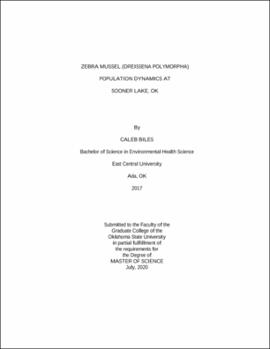| dc.contributor.advisor | Stoodley, Scott | |
| dc.contributor.author | Biles, Caleb | |
| dc.date.accessioned | 2021-02-22T22:41:27Z | |
| dc.date.available | 2021-02-22T22:41:27Z | |
| dc.date.issued | 2020-07 | |
| dc.identifier.uri | https://hdl.handle.net/11244/328679 | |
| dc.description.abstract | Zebra mussels (Dreissena polymorpha) are native to Europe and were first reported in North America in the late 1980s at Lake St. Clair in Michigan. They negatively impact ecosystems, recreation, and facilities that use surface water such as public water supply plants, power generation facilities, and industrial facilities throughout North America. Understanding the life history characteristics of zebra mussels and the environmental factors that limit their success is critical for managing zebra mussel infestations. Zebra mussel population dynamics are influenced by temperature. Oklahoma was previously considered the southernmost portion of the zebra mussels' invasive range because of increased water temperatures. Zebra mussels are currently distributed as far South as Austin, Texas. This suggests that zebra mussels can and will continue to invade aquatic ecosystems that are characterized by extreme temperatures. Zebra mussels were first reported in Oklahoma in 1993 and in Sooner Lake in 2006. Sooner Lake is used to cool a coal-fired power generation facility that lies directly adjacent to the lake. Heated effluent that continually discharges from the facility has created an artificial thermal gradient with temperatures decreasing away from the discharge channel. This artificial thermal gradient provides a unique opportunity to study how zebra mussels react to a wide range of temperatures within a single reservoir. The purpose of this study was to: 1) document the extent of the thermal gradient at Sooner Lake, and 2) compare zebra mussel veliger densities along the temperature gradient to determine how temperature affects zebra mussel population dynamics and reproductive success. A significant thermal gradient was found at Sooner Lake where temperatures were approximately 10 °C warmer in the discharge channel compared to the main body of the lake during the summer months. Veliger densities differed along this thermal gradient. These differences were not consistent between sites and not always driven by temperature. This indicates that other environmental variables are important for zebra mussels. A maximum density of 120 veligers/L occurred at the intake while on the same date 114 veligers/L were recorded at the discharge buoy where temperatures were much higher. A rapid decrease in temperatures to suboptimal conditions was likely responsible for the lack of a secondary spawn in 2019. This study found that both high and low temperatures can have negative impacts on the reproductive success of zebra mussels. These results suggest that zebra mussels along the southern invasion front have a high tolerance to extreme water temperatures and are capable of persisting long term in such environments. | |
| dc.format | application/pdf | |
| dc.language | en_US | |
| dc.rights | Copyright is held by the author who has granted the Oklahoma State University Library the non-exclusive right to share this material in its institutional repository. Contact Digital Library Services at lib-dls@okstate.edu or 405-744-9161 for the permission policy on the use, reproduction or distribution of this material. | |
| dc.title | Zebra mussel (Dreissena polymorpha) population dynamics at Sooner Lake, OK | |
| dc.contributor.committeeMember | Dzialowski, Andy | |
| dc.contributor.committeeMember | Hickman, Karen | |
| osu.filename | Biles_okstate_0664M_16891.pdf | |
| osu.accesstype | Open Access | |
| dc.type.genre | Thesis | |
| dc.type.material | Text | |
| dc.subject.keywords | sooner lake | |
| dc.subject.keywords | temperature | |
| dc.subject.keywords | thermal gradient | |
| dc.subject.keywords | zebra mussels (dreissena polymorpha) | |
| thesis.degree.discipline | Environmental Science | |
| thesis.degree.grantor | Oklahoma State University | |
